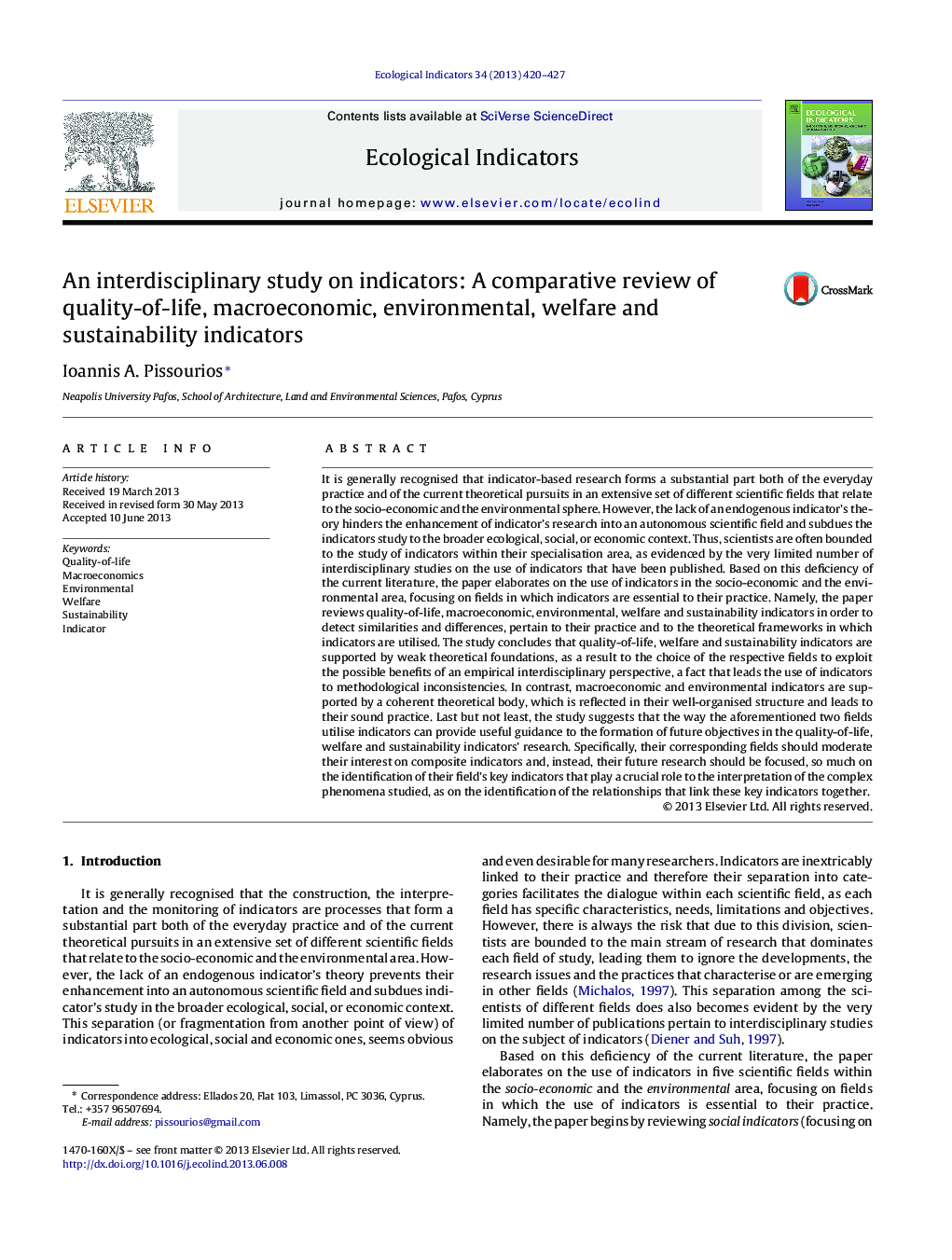| کد مقاله | کد نشریه | سال انتشار | مقاله انگلیسی | نسخه تمام متن |
|---|---|---|---|---|
| 6295322 | 1617166 | 2013 | 8 صفحه PDF | دانلود رایگان |
عنوان انگلیسی مقاله ISI
An interdisciplinary study on indicators: A comparative review of quality-of-life, macroeconomic, environmental, welfare and sustainability indicators
ترجمه فارسی عنوان
یک مطالعه بین رشته ای بر روی شاخص ها: یک بررسی مقایسه ای از شاخص های کیفیت زندگی، شاخص های اقتصاد کلان، محیط زیست، رفاه و پایداری
دانلود مقاله + سفارش ترجمه
دانلود مقاله ISI انگلیسی
رایگان برای ایرانیان
کلمات کلیدی
کیفیت زندگی، اقتصاد کلان، محیطی، رفاه، پایداری، شاخص
ترجمه چکیده
به طور کلی به رسمیت شناخته شده است که تحقیق مبتنی بر شاخصه بخش مهمی از فعالیت های روزمره و فعالیت های نظری فعلی را در مجموعه وسیعی از زمینه های علمی مختلف مرتبط با حوزه های اجتماعی-اقتصادی و محیط زیست تشکیل می دهد. با این حال، فقدان تئوری شاخص اندوژن مانع پیشرفت تحقیقات شاخص در زمینه علمی مستقل می شود و مطالعات شاخص ها را به محیط زیستی، اجتماعی و اقتصادی گسترده تر می بخشد. بنابراین، دانشمندان اغلب به مطالعه شاخص ها در حوزه تخصصی خود محدود می شوند، همانگونه که تعداد مطالعات میان رشته ای در مورد استفاده از شاخص هایی که منتشر شده اند، نشان داده شده است. بر اساس این کمبود ادبیات فعلی، مقاله در مورد استفاده از شاخص ها در منطقه اجتماعی-اقتصادی و محیط زیست، با تمرکز بر زمینه هایی که شاخص ها برای عملکرد آنها ضروری است، بحث می کنند. یعنی مقاله بررسی کیفیت زندگی، شاخص های اقتصاد کلان، محیط زیست، رفاه و پایداری را به منظور تشخیص شباهت ها و تفاوت ها، مربوط به عمل و چارچوب های نظری که در آن شاخص ها استفاده می شود، بررسی می کند. این مطالعه نشان می دهد که شاخص های کیفیت زندگی، رفاه و پایداری با پایه های نظری ضعیف، به عنوان نتیجه انتخاب رشته های مربوطه برای بهره برداری از مزایای احتمالی یک چشم انداز بین رشته ای تجربی، حقیقی که منجر به استفاده از شاخص ها ناسازگاری متدولوژیک. در مقابل، شاخص های اقتصاد کلان و محیط زیست با یک بدن نظری منسجم، که در ساختار سازماندهی شده خود منعکس شده و منجر به عملکرد صحیح آنها می شود، حمایت می شود. آخرین و مهمترین نکته این مطالعه نشان می دهد که چگونگی استفاده از شاخص های دو مفهوم فوق می تواند هدایای مفیدی برای ایجاد اهداف آتی در تحقیقات شاخص های کیفیت زندگی، رفاه و توسعه پایدار باشد. به طور خاص، زمینه های مربوطه آنها باید شاخص های کامپوزیت خود را منحرف کنند، و در عوض، تحقیقات آینده خود باید بر روی شناسایی شاخص های کلیدی زمینه خود که نقشی حیاتی را در تفسیر پدیده های پیچیده مورد مطالعه قرار می دهند متمرکز شود، شناسایی روابط است که این شاخص های کلیدی را با هم مرتبط می کند.
موضوعات مرتبط
علوم زیستی و بیوفناوری
علوم کشاورزی و بیولوژیک
بوم شناسی، تکامل، رفتار و سامانه شناسی
چکیده انگلیسی
It is generally recognised that indicator-based research forms a substantial part both of the everyday practice and of the current theoretical pursuits in an extensive set of different scientific fields that relate to the socio-economic and the environmental sphere. However, the lack of an endogenous indicator's theory hinders the enhancement of indicator's research into an autonomous scientific field and subdues the indicators study to the broader ecological, social, or economic context. Thus, scientists are often bounded to the study of indicators within their specialisation area, as evidenced by the very limited number of interdisciplinary studies on the use of indicators that have been published. Based on this deficiency of the current literature, the paper elaborates on the use of indicators in the socio-economic and the environmental area, focusing on fields in which indicators are essential to their practice. Namely, the paper reviews quality-of-life, macroeconomic, environmental, welfare and sustainability indicators in order to detect similarities and differences, pertain to their practice and to the theoretical frameworks in which indicators are utilised. The study concludes that quality-of-life, welfare and sustainability indicators are supported by weak theoretical foundations, as a result to the choice of the respective fields to exploit the possible benefits of an empirical interdisciplinary perspective, a fact that leads the use of indicators to methodological inconsistencies. In contrast, macroeconomic and environmental indicators are supported by a coherent theoretical body, which is reflected in their well-organised structure and leads to their sound practice. Last but not least, the study suggests that the way the aforementioned two fields utilise indicators can provide useful guidance to the formation of future objectives in the quality-of-life, welfare and sustainability indicators' research. Specifically, their corresponding fields should moderate their interest on composite indicators and, instead, their future research should be focused, so much on the identification of their field's key indicators that play a crucial role to the interpretation of the complex phenomena studied, as on the identification of the relationships that link these key indicators together.
ناشر
Database: Elsevier - ScienceDirect (ساینس دایرکت)
Journal: Ecological Indicators - Volume 34, November 2013, Pages 420-427
Journal: Ecological Indicators - Volume 34, November 2013, Pages 420-427
نویسندگان
Ioannis A. Pissourios,
